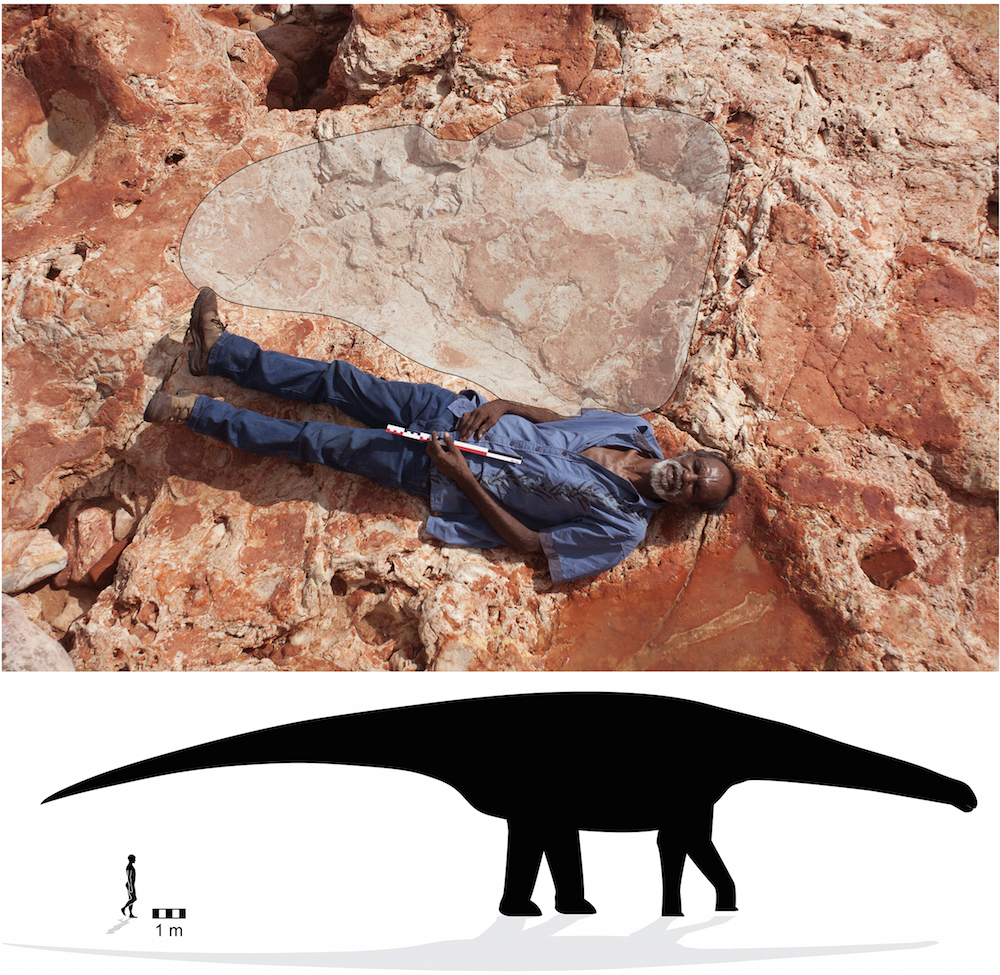Crikey! Refrigerator-Size Dinosaur Footprints Discovered in Australia

Refrigerator-size dinosaur footprints are just some of the trackways that make the western coast of Australia the most diverse place on Earth for dinosaur footprints, a new study finds.
There are so many kinds of dinosaur footprints on the Dampier Peninsula — 21 different types in all — that researchers are calling the 15.5-mile (25 kilometers) stretch "Australia's Jurassic Park." (However, that's a bit of a misnomer; the prints were made from about 140 million to 127 million years ago, during the Cretaceous period.)
The peninsula includes several footprints that are about 5.5 feet (1.7 meters) long, making them among the largest known dinosaur footprints in the world, the researchers said. These prints likely belonged to a sauropod, a long-necked, long-tailed, herbivorous dinosaur. But other, smaller prints found there were likely from carnivores and other plant-eating dinosaurs, they said. [See Photos of the Dinosaur Footprints in Australia's "Jurassic Park"]
The footprints are interwoven into the culture of the Goolarabooloo, the Aboriginal people who call themselves the traditional custodians of the region. The prints are part of a song cycle that relates to the creation story for the Goolarabooloo, and explains how the tracks show the journey of a creator known as Marala, the emu man, the researchers said.
"Marala was the lawgiver," said Phillip Roe, a Goolarabooloo law boss. "He gave [our] country the rules we need to follow: how to behave, to keep things in balance."
Marala left behind three-toed track marks, which scientists now recognize as the tracks of meat-eating dinosaurs called theropods, Steve Salisbury, a paleontologist at the University of Queensland (UQ) in Australia and the study's lead researcher, said in a statement.
In 2008, the Western Australia government chose the area — also known as Walmadany, or James Price Point — as the ideal site for a $40 billion liquid-natural-gas processing precinct. When the Goolarabooloo learned about the development, they contacted Salisbury and his colleagues, who spent more than 400 hours examining and documenting the dinosaur footprints.
Get the world’s most fascinating discoveries delivered straight to your inbox.
"We needed the world to see what was at stake," Roe said. "It's great to work with UQ researchers. We learnt a lot from them, and they learnt a lot from us."
The paleontologists had to dodge sharks, crocodiles and high tides while studying the dinosaur footprints. These footprints are known as trace fossils, meaning they were left by the animal but aren't part of the animal itself. Other examples of trace fossils include fossilized burrows and coprolites, or fossilized poop.
The trace fossils show the diversity of dinosaurs that lived around Walmadany during the Cretaceous period, said Salisbury, who called it the "Cretaceous equivalent of the Serengeti."
"It is extremely significant, forming the primary record of nonavian dinosaurs in the western half [of] the continent and providing the only glimpse of Australia's dinosaur fauna during the first half of the early Cretaceous period," Salisbury said.
Walmadany has thousands of tracks. "Of these, 150 can confidently be assigned to 21 specific track types, representing four main groups of dinosaurs," Salisbury said.
Analyses revealed that five different track types belonged to predatory dinosaurs; at least six track types were made by sauropods; four track types were made by two-legged herbivorous ornithopods (for instance, the duck-billed dinosaur is an ornithopod, but it's unclear which dinosaur left these marks); and another six were from armored dinosaurs.
The findings show that Broome, a town on the western coast of Australia was once a dinosaur hotspot, Salisbury said. [In Photos: Baby Stegosaurus Tracks Unearthed]
"Most of Australia's dinosaur fossils come from the eastern side of the continent, and are between 115 [million] and 90 million years old," he said. "The tracks in Broome are considerably older."
Salisbury noted that political issues made the project "particularly intense," and was relieved when the Australian Government gave it National Heritage status in 2011. The plan for the gas project fell apart in 2013, he added.
The outcome is uplifting, in part because dinosaur footprints can help researchers learn about dinosaur anatomy, diversity and evolution, said Steve Brusatte, a paleontologist at the University of Edinburgh, in Scotland, who was not involved in the study.
"What stands out are [the footprints'] immense physical size and the great variety of dinosaur tracks found there," Brusatte told Live Science in an email. "Obviously, this part of Australia must have been a dinosaur stomping ground during the Early Cretaceous."
The findings were published online March 24 in the Journal of Vertebrate Paleontology.
Original article on Live Science.

Laura is the managing editor at Live Science. She also runs the archaeology section and the Life's Little Mysteries series. Her work has appeared in The New York Times, Scholastic, Popular Science and Spectrum, a site on autism research. She has won multiple awards from the Society of Professional Journalists and the Washington Newspaper Publishers Association for her reporting at a weekly newspaper near Seattle. Laura holds a bachelor's degree in English literature and psychology from Washington University in St. Louis and a master's degree in science writing from NYU.



